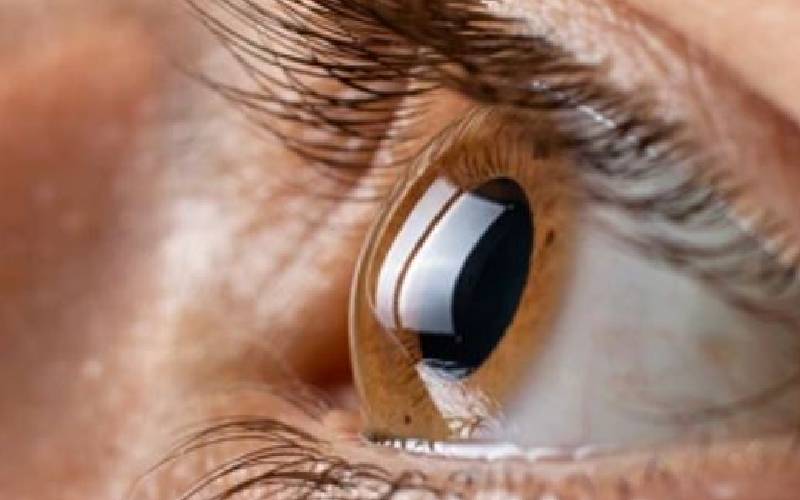Ruth Bitutu, a music teacher, almost lost her eyesight from an eye condition she kept ignoring until she couldn’t read with her new glasses-yet reading music is common fare.
The violinist and owner of Music by Bitutu recalls that “when I was teaching my children music I was making mistakes and realized I was not seeing well especially with my left eye,” recalls Ruth adding that she visited an ophthalmologist this July who told her “something wrong with my cornea and it’s beyond me” and referred her to another specialist.
Ruth was diagnosed with a potentially blinding disease called Keratoconus – which affects the human cornea, the transparent foremost part of the eye resulting in loss of vision.
The condition makes the cornea bulge outwards but Ruth says “I never had the problem before, I have been having glasses for the past 17 years and my prescription was getting stronger every day” and “I was reading more than negative four and had very high astigmatism (treatable imperfection in the curvature of the eye).”
Dr Mukesh Joshi, an ophthalmologist and the medical director of Laser Eye Centre, explains that the cornea is like a watch glass. Sometimes because of the weakness of the center part of the cornea which is made up of collagen, it becomes weak and starts bulging then takes the shape of the con and that’s what is called keratoconus.
Ruth needed surgery, a special procedure known as cross-linking and cornea regularization to stop the progression of the keratoconus but which would “not improve my eyesight that was a problem because I was not able to read well. As a violinist, I had to quit the orchestra. I was frustrated by that diagnosis.”
The challenge was to get a good doctor who could do the operation as facilities in Nairobi had visiting doctors and being on a waiting list was not an option, because as more time passed the more her vision become blurred.
Keratoconus affects both eyes with degree of progression in each eye often unequal.
“So I got a doctor who could do something extra apart from cross-linking that could improve my eyesight completely. He said he would do cornea regulation on my right eye but the left eye was too risky.”
Keratoconus is said to be the highest cause of blindness among youths in East Africa, and Dr Joshi adds East Africa leads in keratoconus cases in the world with the biggest challenge being late diagnosis with symptoms including frequent changing of glasses and inability to see properly at night even rubbing eyes. These symptoms first appear during puberty or late teens into mid-30s with one common cause being the loss of collagen in the cornea.
Dr Joshi adds that about “15 years ago there was no treatment for keratoconus we only did cornea transplant. Now we have cornea regularization we reshape the cornea then we cross-link. Another treatment is cornea transplant if it’s not advanced we do laser. Cornea transplant is the most successful transplant among body organs.”
Dr Joshi says cataracts come first among major causes of blindness among people followed by glaucoma, Diabetic Retinopathy then Keratoconus-which is the cause of blinding for most young people below 20.
![]()

Ruth booked herself for surgery of which she recalls: “First they cleaned my eyes, it’s just like a normal theatre, you lie there and there was a red light close to your eyes. You are not supposed to blink so my eyes were clipped. They kept on putting eye drops in the eye, cornea regularization was done then later cross-linking which is a more complicated surgery a layer of the cornea is removed.”
She continues: “They had put a contact lens in my eyes to cover the part of the cornea that was removed. I stayed home with shades because I had sensitivity to light. In few days I could look at my phone a little, after five days the lenses were removed.”
With new technology cross-linking surgery is not invasive, but Ruth still uses her glasses because her left eye is still infected.
“In two weeks I could read from my laptop, due to change in power in my right eye I got a new prescription glasses for my right eye but maintained the old prescription for my left eye,” says Ruth.
Being self-employed she needed to resume teaching and the doctor allowed her to drive with protected shades to prevent her eyes from the exposure to Ultra Violet light and “I can now read car number plates and I have driven at night” and poor vision had affected her life such that she had to finish most tasks before sunsets.
Even after surgery, Keratoconus sticks around
Keratoconus can be genetic but not hereditary and treatments focuses on the correction of vision depending on its stage.
Keratoconus doesn’t happen in one day and early signs including blurred vision, inability to see in dim light, or sensitivity to light and glare progress slowly and in the case of Ruth light allergies were discovered when she turned nine when she would start itching when subjected to bright light and “sometimes the eyes turned red, I would be given eye drops and would be fine. When I was 16, I sat at the back of the class and realized I could not read properly, it was discovered I had astigmatism. I survived with glasses all through until four years ago when I lost my thyroid and that’s when I started having problems seeing.”
Ruth asked if any family members suffered keratoconus before and the list included “a cousin who had a cornea transplant and his sister had to cross-link a few years later and now my uncle has keratoconus and had surgery last week,” she explains adding that “my family members tell me it’s chronic. Even after surgery, it’s not that the disease goes away but it just stops it.”
Credit: Source link